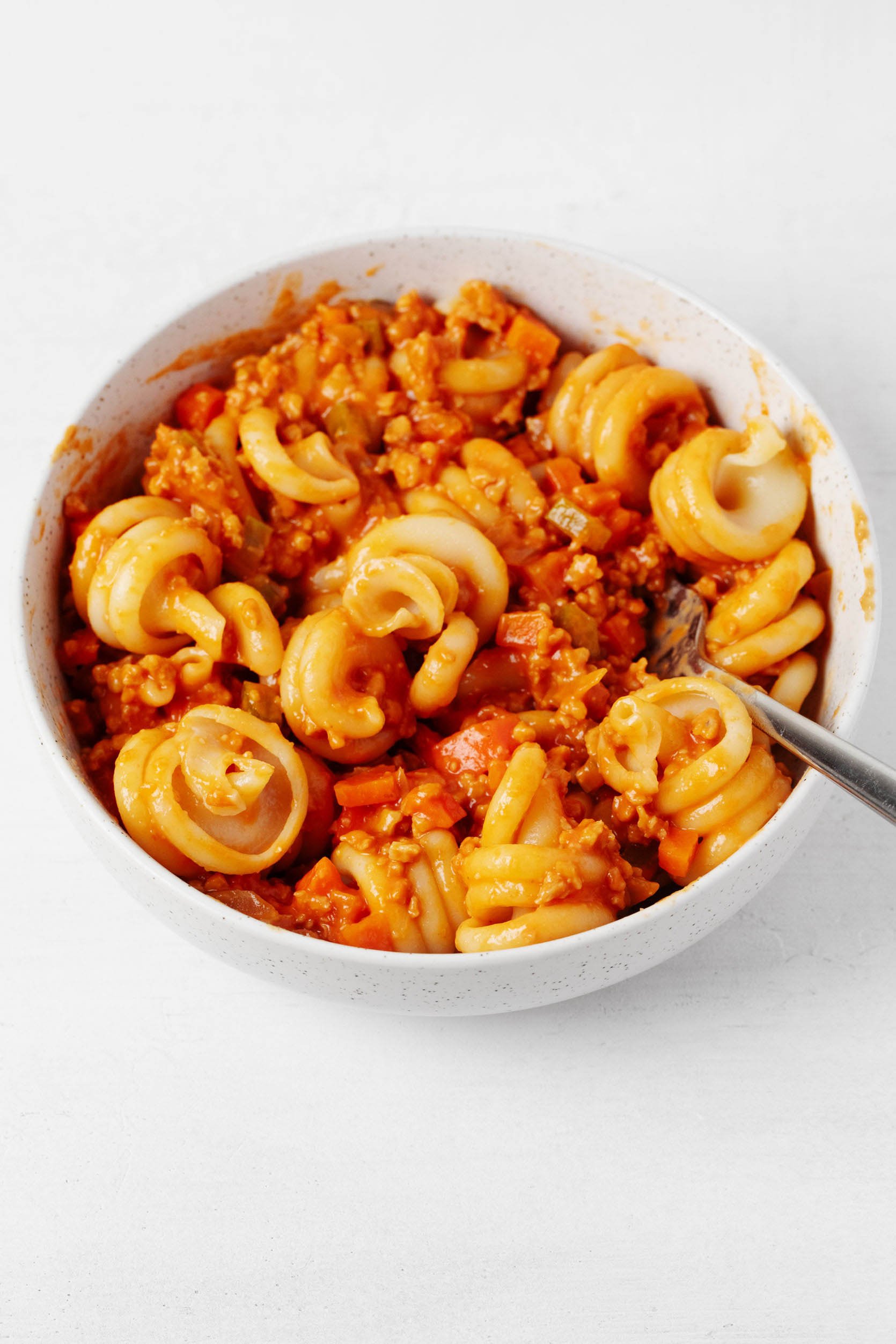This meaty vegan Bolognese sauce uses TVP, rather than lentils or mushrooms, for authentic texture and a big boost of plant protein! The sauce is also made with onion, carrot, celery, strained tomatoes, and a touch of cashew cream. This Bolognese is less tomato-driven than many others, so it’s not overly acidic, and you’ll truly taste its vegetables.
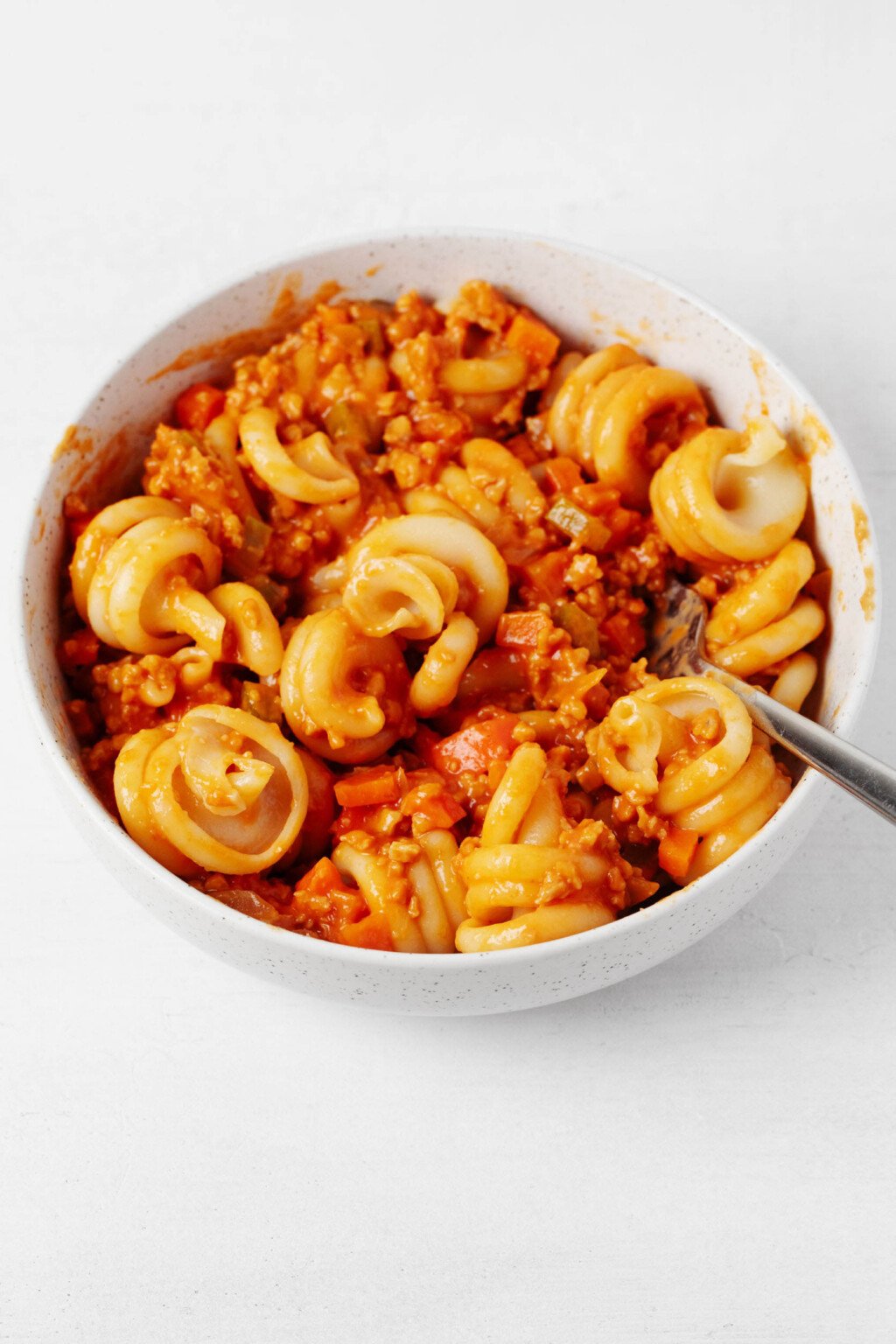
As a pasta lover who is also a longtime plant-based eater, I’ve experimented with many vegan Bolognese recipes.
This vegan Bolognese with TVP is my favorite. It’s hearty, affordable to make, and so very tasty.
What makes the sauce special is that it’s got an authentically “meaty” texture. Similar to traditional Bolognese, it’s also rich in protein.
Both of these features are thanks to the use of TVP, or texturized vegetable protein. TVP is a versatile, inexpensive, and nutritious ingredient made from soy beans.
Once you start cooking with TVP, you’ll quickly find that it’s a perfect addition to plant-based tacos, stir fries, chili recipes, and more.
But let’s start with vegan Bolognese—a quintessential comfort food dish.
A more authentic Bolognese
When I set out to test a recipe, I usually discover that I knew less about it than I thought I did. Bolognese is a perfect example of this.
In my mind, Bolognese was a thick tomato sauce with meat. I suspected there might be a difference between Bolognese and ragù, but I didn’t know what it was. Nor was I confident about the distinction between Bolognese vs. an Italian American meat sauce.
Here’s what I was right about: Bolognese is a meat sauce, and it often incorporates tomatoes.
My first misconception was in thinking that Bolognese is supposed to be as tomato-forward as Italian American meat sauce.
Bolognese isn’t marinara sauce with ground meat added. In fact, it’s closer to the other way around. Some recipes call only for a couple tablespoons of tomato paste.
I was also surprised—and glad!—to learn that Bolognese often incorporates milk, or cream.
I love a creamy pasta sauce. Creamy vegan mushroom pasta, light and creamy vegan zucchini pasta, and creamy 8-ingredient vegan pumpkin pasta are all staple recipes in my home.
In the category of pasta that’s both meaty and creamy, my creamy vegan skillet lasagna is a forever favorite. This bolognese recipe is a close relative.
Bolognese vs. Ragù
How is Bolognese different from ragù?
It isn’t, actually. Bolognese is a type of ragù. Ragù is a meat-based sauce that can take on many regional variations, including different types of proteins.
Ragù alla Bolognese refers to a ragù that’s named after the city of Bologna (whether or not it actually originated there).
Ragù alla Bolognese begins with a sautéed mixture of carrot, onion, and celery, to which meat is added. Tomatoes can be involved, but they don’t strictly have to be. Dairy is usually stirred in toward the end of simmering.
Vegan Bolognese is highly non-traditional in that it excludes meat. But I tried to make this one more authentic than versions I’ve tried in the past.
The vegetables are prominent. All-purpose vegan cashew cream adds a lovely, light creaminess.
And while you won’t find any beef here, you will find a plant protein that’s notable for its meaty texture.
For the love of TVP
TVP belongs in a category of what I think of as “old school” vegan ingredients. I’d put seitan, soy curls, Tofurky, and even nutritional yeast into the same group.
It’s not that these foods are obsolete. On the contrary, they’re all available and as useful as ever.
But these are ingredients that existed before vegan meats and vegan cheeses had gotten high-tech. If you’ve been vegan for a long time, you can probably remember cooking with them before grocery store shelves were full of vegan protein options.
TVP is a protein that comes from soybeans. Specifically, it’s made when roasted soybeans are ground into flour, defatted, and then dried.
You can purchase TVP online or in most health food stores. Unprepared, it’ll look dry and crumbly; I think it resembles bulgur wheat.
After you rehydrate the TVP in hot liquid, like water or broth, it will more closely resemble ground meat.
I say “closely” because TVP won’t fool an unsuspecting meat eater. It’s not as realistic as, say, Impossible Ground Beef.
Once cooked, however, TVP does have a pleasantly chewy texture, which I’d describe as “meaty.”
So many vegan Bolognese recipes call for lentils. I love a lentil, but lentil-enriched pasta sauce doesn’t strike me as being meaty, even if it’s delicious.
Some longterm plant-based eaters come to dislike products that are realistically meat-like. I understand this, but I don’t relate. I crave meaty textures, and mushrooms don’t always cut it!
This recipe will help you get closer to a true meat sauce in your kitchen. And it will allow you to do that without spending lots of money on store-bought vegan meats.
TVP nutrition
In addition to being inexpensive, versatile, and having a fun texture, TVP has nutrient richness to offer you.
A quarter cup of dry TVP—that’s about half a cup once you’ve rehydrated it—has about ten to twelve grams of protein. This is more than a half cup of beans and about the same as a four ounce serving of tofu.
The same portion of TVP will also provide 10% of your recommended daily allowance (RDA) of iron and 15% of your RDA of potassium.
For those who are mindful of fats in their diets, TVP is virtually a fat free food until you season it.
The same goes for sodium: unlike store-bought vegan meats, which are usually generously seasoned, TVP is naturally low-sodium. You can control the saltiness and flavors however you like.
How to make vegan Bolognese with TVP
Step 1: Reconstitute the TVP
You’ll begin by rehydrating, or reconstituting, your TVP. This is as simple as adding the dry TVP to a bowl, then soaking it in hot water.
Specifically, you’ll use two cups of boiling water for one cup of dry TVP. Pour the water over the vegetable protein, then allow it to soak for ten minutes.
(It’s possible to soak it longer in room-temperature water for the same result, but I prefer to save time with hot liquid.)
Drain the TVP through a fine-mesh strainer, pressing it gently to remove as much moisture as you can.
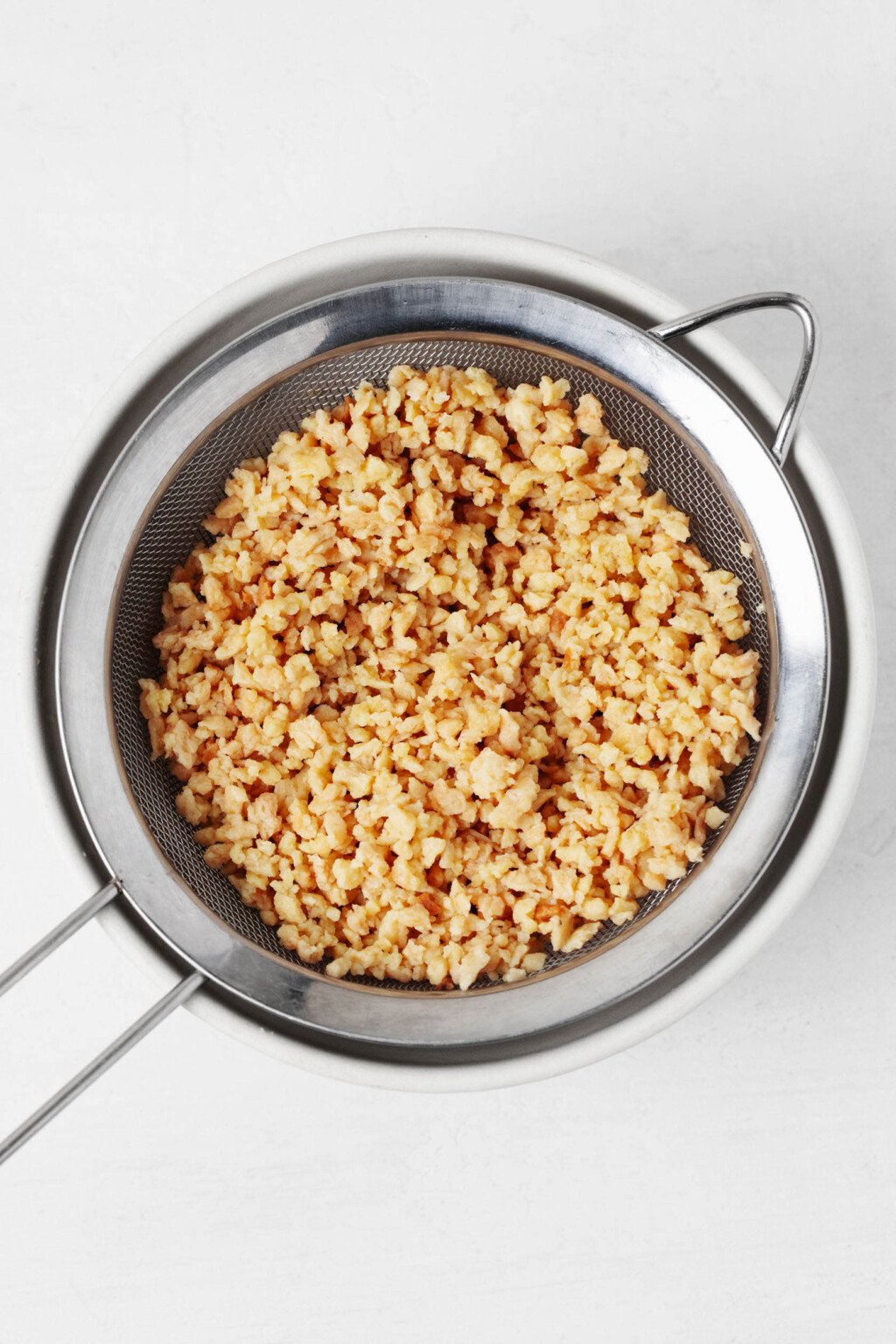
Then set the TVP aside as you cook your vegetable mixture.
Step 2: Sauté your vegetables
Heat some olive oil over medium heat in a large, deep skillet, then add the onion, carrot, and celery.
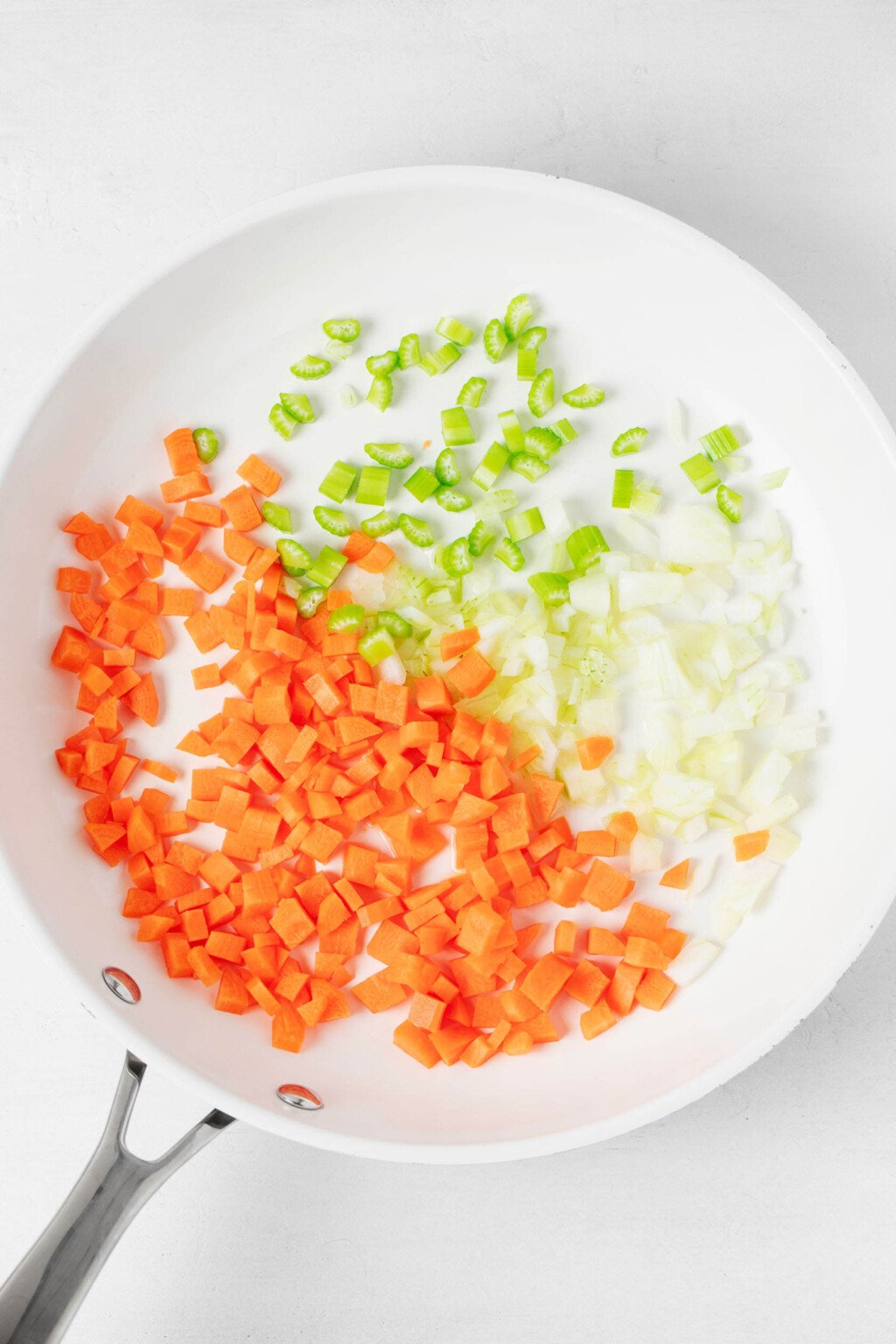
You’ll cook the vegetables for 6-7 minutes, or until tender. Deglaze the pan with some wine wine (substitute vegetable broth if wine isn’t for you).
Then, add your flavor base to the skillet: this is tomato paste and Bragg’s liquid aminos or tamari. These additions add umami to the recipe.
Step 3: Add the TVP to the skillet
Add the TVP to the skillet, then sprinkle it with some nutritional yeast. The latter adds savoriness to the Bolognese, along with some added protein.
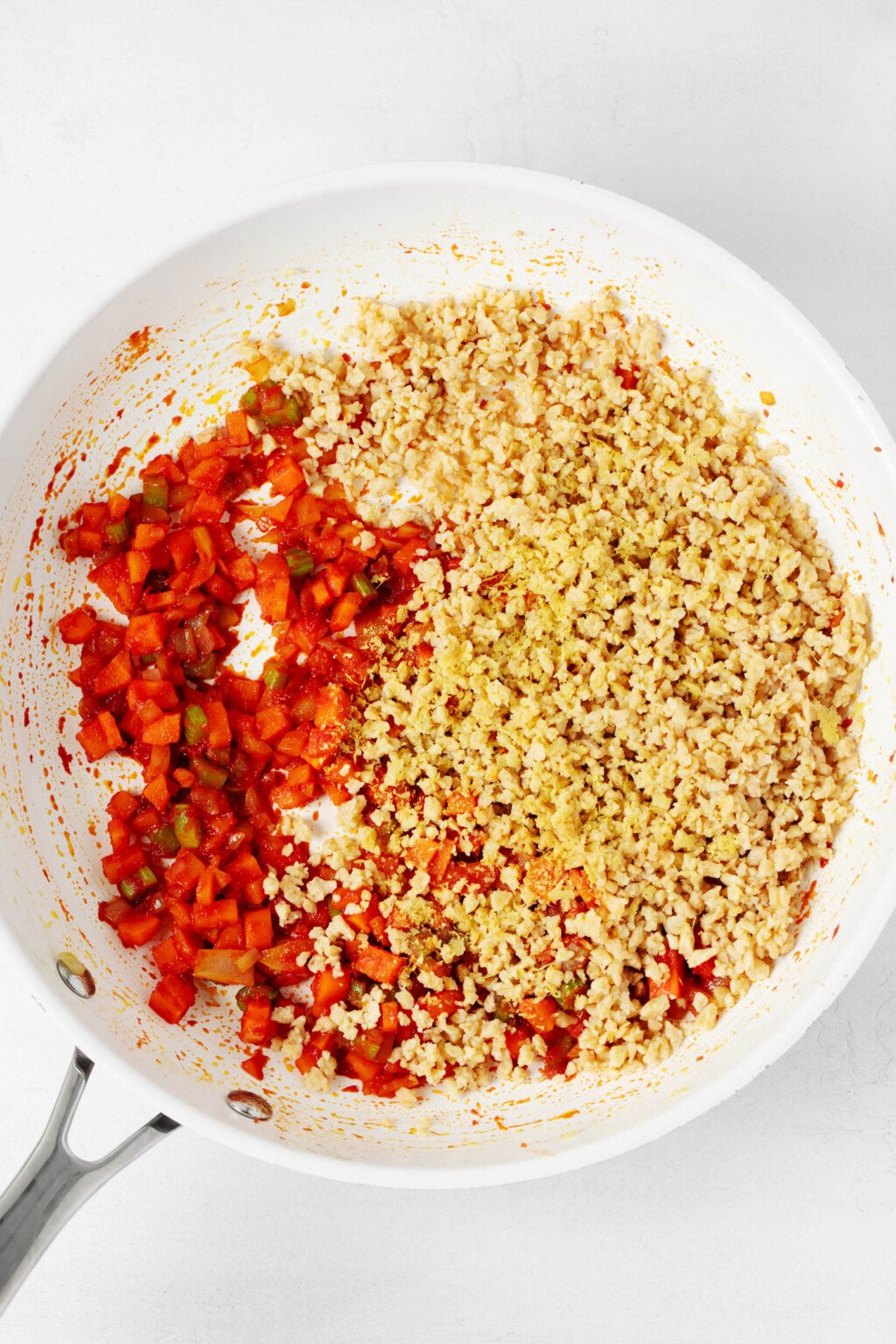
Step 4: Add strained tomatoes, then cashew cream
Finally, you’ll stir one and a half cups of strained tomatoes to the skillet.
This isn’t a huge amount, and using strained tomatoes (passata), rather than diced, creates a light effect. You can substitute crushed tomatoes or diced tomatoes for strained if that’s what you have.
Simmer the mixture for three to five minutes, or until it’s bubbly and thick. Finally, stir in three quarters of a cup of cashew cream, the recipe’s creamy component.
Thanks to a deliberate amount of tomato and the cashew cream, the acidity of this vegan Bolognese is less than other tomato-based sauces that I make regularly, such as my 20-minute marinara sauce.
It may be a more suitable option for those who have a hard time with high-acid foods.
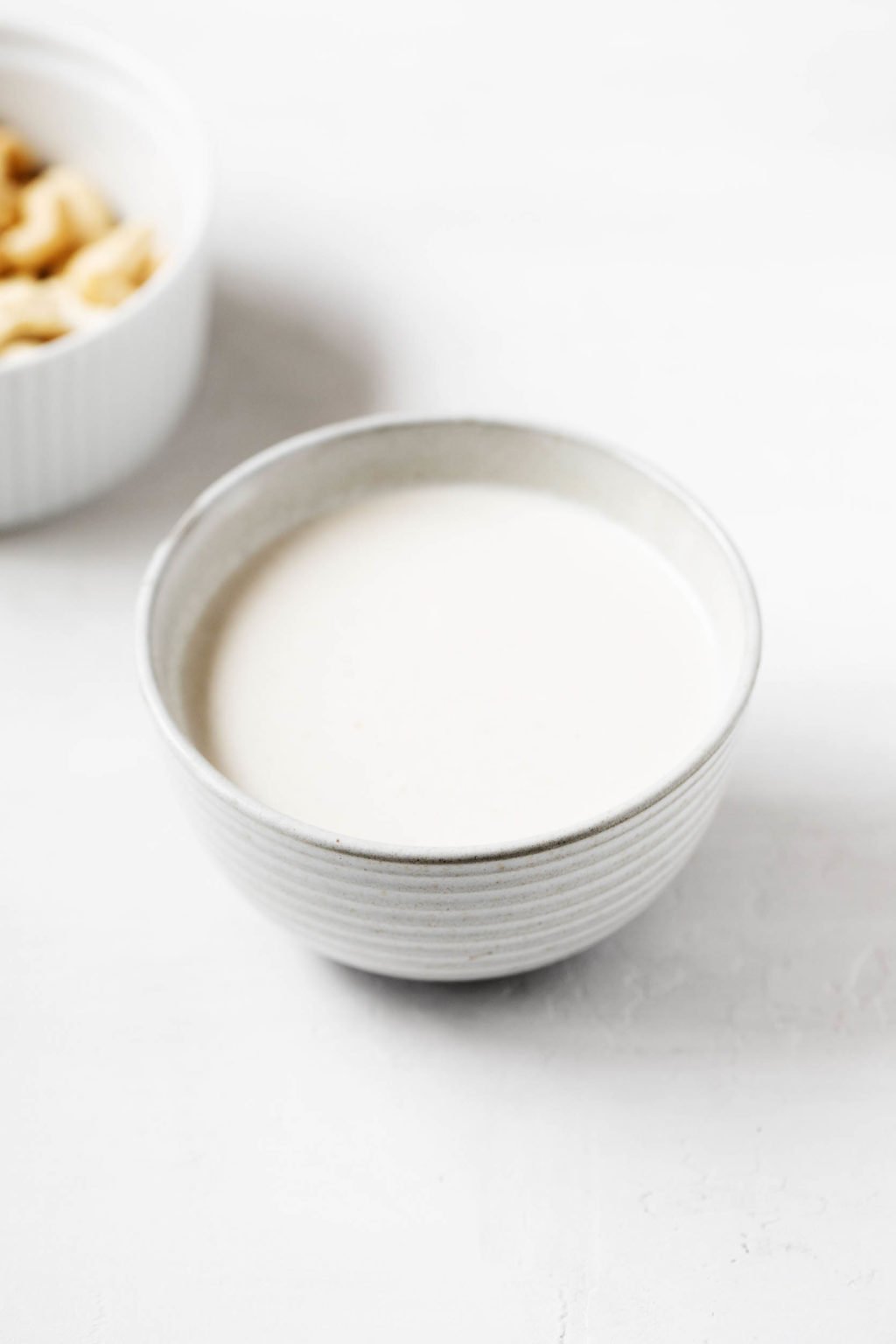
At this point, you’ll have a creamy sauce that’s a bright, orange-pink color. It will be quite textured. I think this recipe is probably thicker than a traditional Bolognese would be.
But there’s a time to honor tradition, and a time break the rules.
Step 5: Boil pasta and serve it with the sauce
Finally, boil your pasta of choice. Drain the pasta, then divide it into bowls or onto plates. Top each portion with a generous heap of the vegan Bolognese, and dig in!
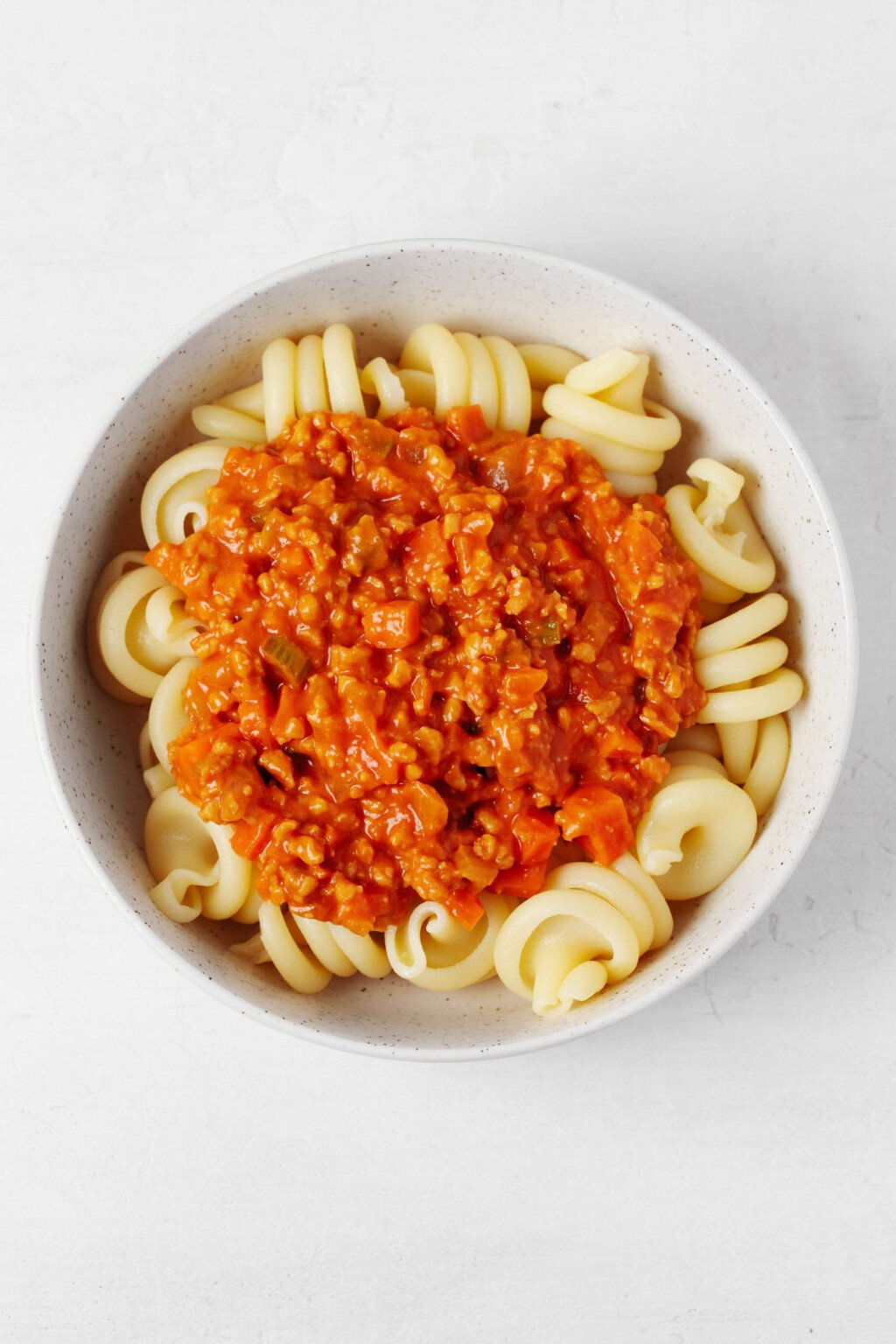
Meal prep & storage
You can make a batch of the vegan Bolognese, boil a big pot of pasta, and serve it all right away to friends or family.
Or, you can prepare the sauce, then store or freeze it. You can freeze it in small amounts (freezer cubes or small containers) if that’s best for your meal prep needs.
No matter how you choose to store the sauce, it will keep in an airtight container in the fridge for up to four days or in the freezer for up to six weeks.
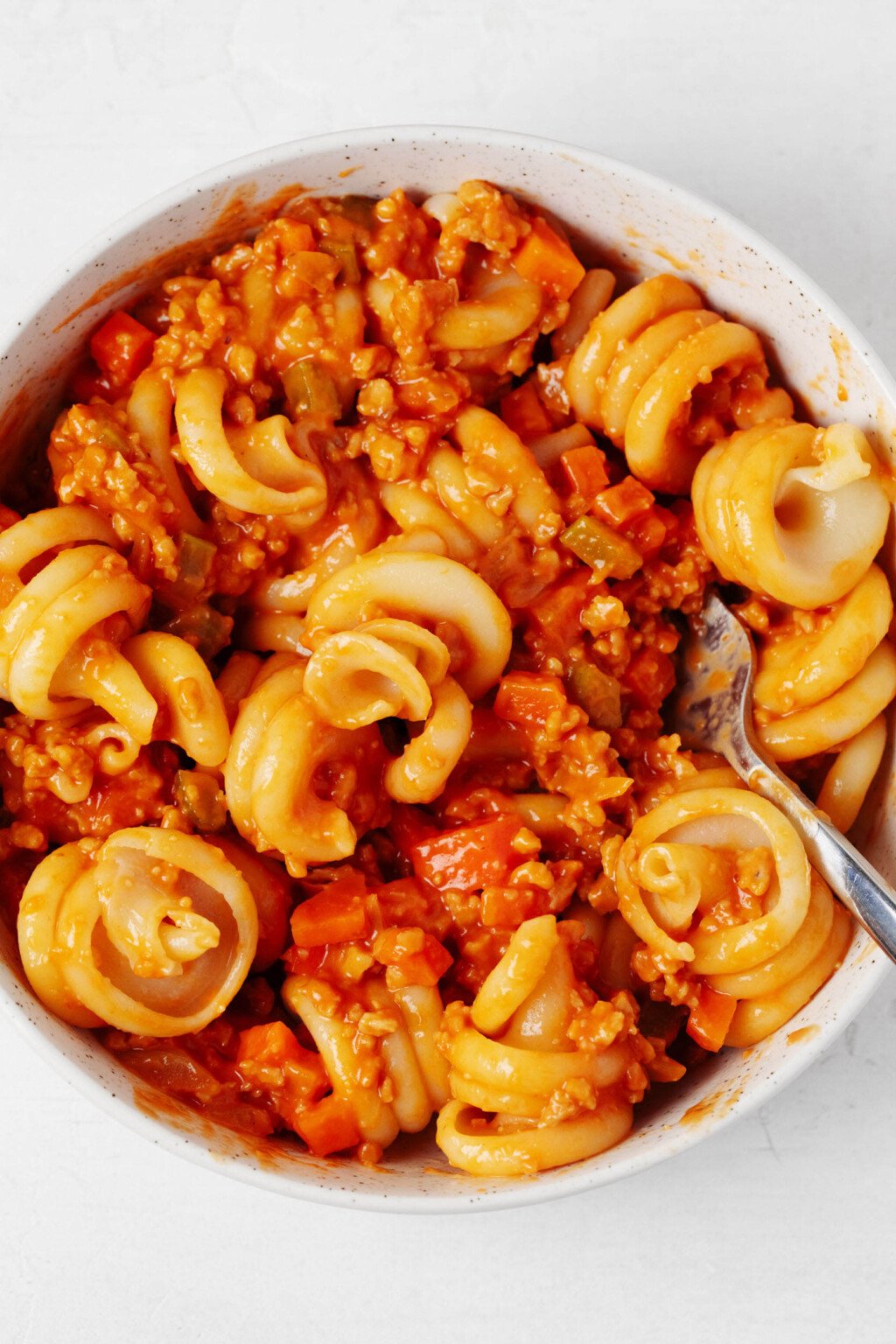

Meaty Vegan Bolognese with TVP (No Lentils)
Author –
Yields: 4 servings
- 2 cups water (480 ml)
- 1 cup TVP (95 g)
- 2 tablespoons olive oil
- 1 small yellow onion, finely dice
- 2 carrots, trimmed, peeled, and finely diced
- 2 stalks celery, finely diced
- 1/2 cup dry white wine (120 ml)
- 2 tablespoons tomato paste (60 g)
- 1 1/2 tablespoons Bragg Liquid Aminos or tamari
- 1 tablespoon nutritional yeast
- 1 1/2 cups strained tomatoes (passata) or crushed tomatoes (355 ml; one 14-ounce / 390g can or carton)
- 3/4 cup cashew cream (180 ml)
- Freshly ground black pepper
- 8-12 ounces dry pasta of choice
- salt
-
Bring the two cups of water to a boil in the microwave or in a saucepan. Pour the boiling water over the TVP. Allow the TVP to soak for 10 minutes. Drain the TVP through a fine strainer. While it’s straining, use the bottom of a measuring cup to press down on the TVP, helping to remove as much moisture as possible. Set the TVP aside.
-
Heat the olive oil over medium heat in a large, deep skillet till glistening. Add the onion, carrot, and celery. Cook the vegetables, stirring often, for 6-7 minutes, or until the onion is translucent and all of the vegetables are tender. Add the white wine to the vegetables and cook, stirring occasionally, for 3-4 minutes, or until the wine has nearly all cooked down. Add the tomato paste and Bragg Liquid Aminos or tamari to the skillet. Stir everything well, fully incorporating the tomato paste into the warm mixture.
-
Add the reconstituted TVP to the skillet, then sprinkle the nutritional yeast over it. Give the ingredients a good stir to incorporate well. Add the strained tomatoes to the skillet. Turn the heat to low and simmer the sauce for 3-5 minutes, or until it’s bubbly and thick. Stir the cashew cream into the bolognese and simmer for another 2 minutes, or until it’s hot, fragrant, and lightly creamy. If the sauce is overly thick for your liking, you can add a splash of water at this point. Taste the bolognese and add freshly ground black pepper to taste; you can also add a little extra Bragg liquid aminos or tamari, as needed.
-
Bring a pot of salted water to a boil. Add the pasta and cook to your preferred texture, or according to package instructions. Drain the pasta, then serve it with the bolognese. The bolognese will be enough for 4-6 portions, depending on how saucy you like your pasta to be! Enjoy.
I’m a huge champion of legumes. I can’t imagine my culinary life without white beans, chickpeas, black beans, lentils, or split peas.
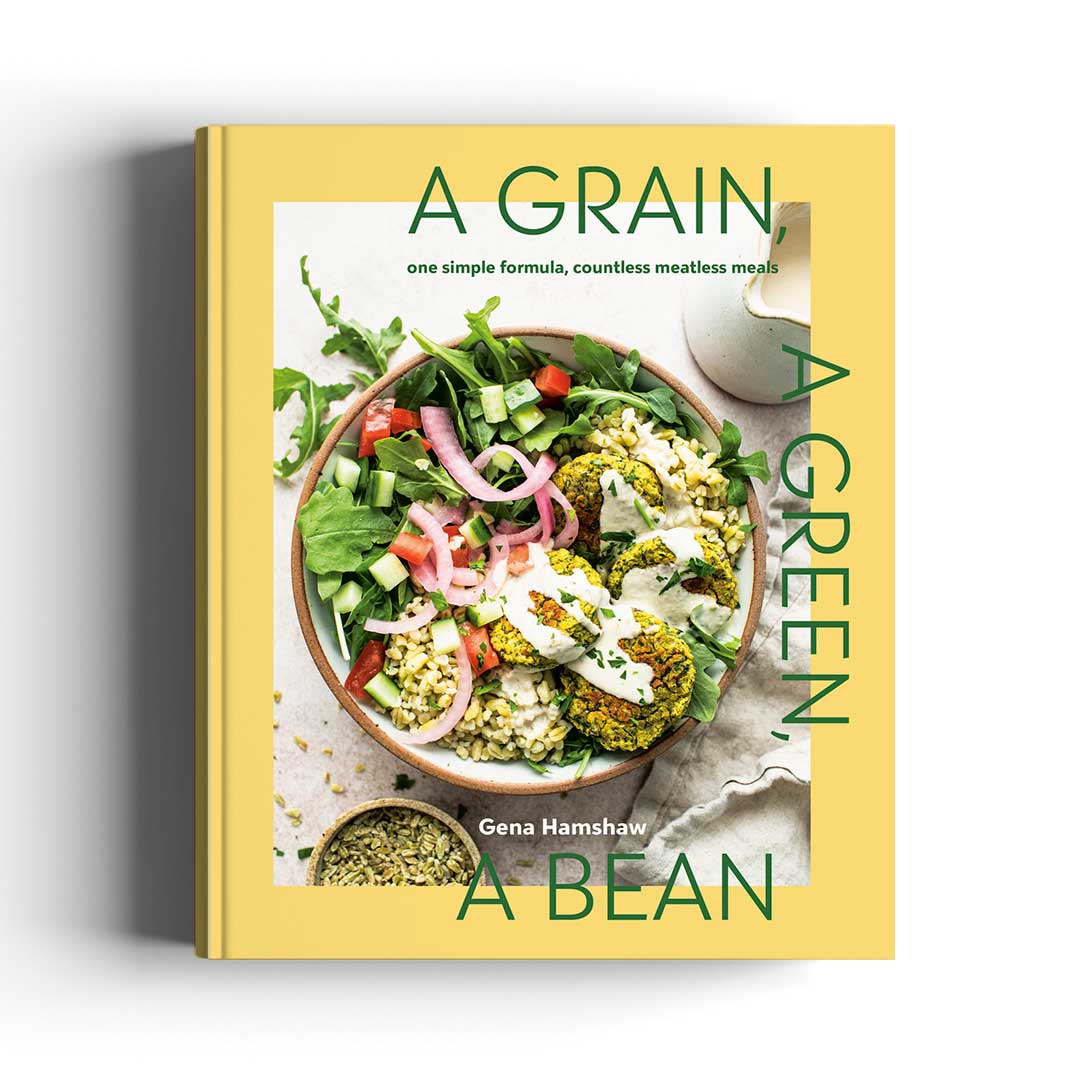
A Grain, a Green, a Bean
A simple trinity of plant-based foods—grains, greens, and beans—will set you up to create an array of beautifully balanced and complete meals. Bring the beans and grains in your pantry to life with more than 80 wholesome recipes and a world of possibilities!
Sometimes it’s worth branching out. Soy beans are unique in their versatility: they can become tofu, tempeh, soy curls, or TVP.
If you’re looking to diversify your plant proteins a little, then TVP is well worth trying. I hope you’ll love what it does for a plant-based Bolognese, and many other recipes!
xo

